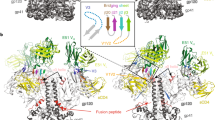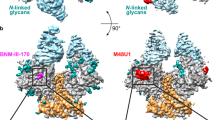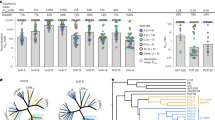Abstract
CD4 functions as a major T-cell surface receptor for human immunodeficiency virus by binding the human immunodeficiency virus type 1 (HIV-1) envelope protein gp120 with relatively high affinity. We have developed constrained aromatically modified analogs of the secondary structures of the first domain of CD4 in order to analyze surfaces involved in binding of gp120. Complementarity determining-like regions (CDRs) of the D1 domain of CD4 were reproduced as synthetic aromatically modified exocyclic (AMEs) forms. The exocyclic CDR3.AME(82-89), derived from the CDRS (residues 82-89) region of CD4 D1 domain, specifically inhibited binding of recombinant gp120 to both recombinant soluble CD4, and CD4+ Jurkat cells, and blocked syncytium formation and virus particle production caused by HIV-1 infection. We have previously shown that the CDR3.AME analog binds to the CD4 CDR3 region and creates a disabled CD4 heterodimer. We propose that the AME prevents the formation of an essential homodimeric surface needed for efficient HIV binding. Additionally the disabled CD4 receptor may be less able to signal the cell to allow HIV replication and HIV infection. Such compounds may represent a new receptor specific approach to modulate biological functions.
This is a preview of subscription content, access via your institution
Access options
Subscribe to this journal
Receive 12 print issues and online access
$209.00 per year
only $17.42 per issue
Buy this article
- Purchase on Springer Link
- Instant access to full article PDF
Prices may be subject to local taxes which are calculated during checkout
Similar content being viewed by others
References
Gay, D., Maddon, P., Sekaly, R., Talle, M.A., Godfrey, M., Long, E., Goldstein, G., Chess, C., Axel, R., Kappler, J., and Marrack, P. 1987. Functional interaction between human T-cell protein CD4 and the major histocompatibility complex HLA-DR antigen. Nature 328: 626–629.
Janeway, C.A. 1989. The role of CD4 in T-cell activation : accessory molecule or co-receptor. Immunol. Today 10: 234–238.
Cammarota, G., Scheirle, A., Takacs, B., Doran, D.M., Knorr, R., Bannwarth, W., Guardiola, J., and Sinigaglia, F. 1992. Identification of a CD4 binding site on the β2 domain of HLA-DR molecules. Nature 356: 799–801.
König, R., Huang, L.Y., and Germain, R.N. 1992. MHC class II interaction with CD4 mediated by a region analogous to the MHC class I binding site for CD8. Nature 356: 796–798.
Saizawa, K., Rojo, J., and Janeway, J.C.A. 1987. Evidence for a physical association of CD4 and CD3: a: β T cell receptor. Nature 328: 260–263.
Klatzmann, D., Champagne, E., Chamaret, S., Gruest, J., Guetard, D., Hercend, T., Gluckman, J.C., and Montagnier, L. 1984. T-lymphocyte T4 molecule behave as the receptor for human retrovirus LAV. Nature 312: 767–768.
Maddon, P.J., Dalgleish, A.G., McDougal, J.S., Clapham, P.R., Weiss, R.A., and Axel, R. 1986. The T4 gene encodes the AIDS virus receptor and is expressed in the immune system and the brain. Cell 47: 333–348.
McDougal, J.S., Nicholson, J.K.A., Cross, G.D., Cort, S.P., Kennedy, M.S., and Mawle, A.C. 1986. Binding of the human retrovirus HTLV-III/LAV/ARV/HIV to the CD4 (T4) molecule: conformation dependence, eprtope mapping, antibody inhibition and potential for idiotypic mimicry. J. Immunol. 137: 2937–2944.
Weiner, D.B., Huebner, K., Williams, W.V., and Greene, M.I. 1991. Human genes other than CD4 facilitate HIV-1 infection of murine cells. Pathobiobgy 59: 361–371.
Feng, Y., Broder, C.C., Kennedy, P.E., and Berger, E.A. 1996. HIV-1 entry cofactor: functional cDNA cloning of a seven-transmembrane, G protein-coupled receptor. Science 272: 872–877.
Alkhatib, G., Combadiere, C., Broder, C.C., Feng, Y., Kennedy, P.E., Murphy, P.M., and Berger, E.A. 1996. CC CKR5: a RANTES, MIP-1 a, MIP-1B receptor as a fusion cofactor for macrophage-tropic HIV-1. Science 272: 1955–1958.
Deng, H.K., Liu, R., Ellmeier, W., Choe, S., Unutmaz, D., Burkhart, M., Di Marzto, P., Marmon, S., Sutton, R.E., Hill, C.M., Davis, C.B., Peiper, S.C., Schall, T.J., Littman, D.R., and Landau, N.R. 1996. Identification of a major co-receptor for primary isolates of HIV-1. Nature 381: 661–666.
Drajic, T., Litwin, V., Allaway, G.P., Martin, S.R., Huang, Y., Nagashima, K.A., Cayanan, C., Maddon, P.J., Koup, R.A., Moore, J.P., and Paxton, W.A. 1996. HIV-1 entry into CD4+ cells Is mediated by the chemokine receptor CC-CKR-5. Nature. 381: 667–673.
Chao, B.H., Costopoulos, D.S., Curiel, T., Bertonis, J.M., Chisholm, P., Williams, C., Schooley, R.T., Rosa, J.J., Fisher, R.A., and Maraganore, J.M. 1989. A 113-amino acid fragment of CD4 produced in Escherichia coliblocks human immunodeficiency virus-induced cell fusion. J. Bid. Chem. 264: 5812–5817.
Arthos, J., Deen, K.C., Chaikin, M.A., Fomwald, J.A., Sathe, G., Sattentau, Q.J., Clapham, P.R., Weiss, R.A., McDougal, J.S., Pietropaolo, C., Axel, R., Truneh, A., Maddon, P.J., and Sweet, R.W. 1989. Identification of the residues in human CD4 critical for the binding of HIV. Cell 57: 469–481.
Clayton, L.K., Hussey, R.E., Steinbrich, R., Rama-Chandran, H., Husain, Y., and Reinherz, E.L. 1988. Substitution of murine for human CD4 residues identifies amino acids critical for HIV-gp120 binding. Nature 335: 363–366.
Mizukami, T., Fuerst, T.R., Berger, E.A., and Moss, B. 1988. Binding region for human immunodeficiency virus (HIV) and epitopes for HIV-blocking monoclonal antibodies of the CD4 molecule defined by site-directed mutagenesis. Proc. Natl. Acad. Sci. USA 85: 9273–9277.
Peterson, A. and Seed, B. 1988. Genetic analysis of monoclonal antibody and HIV binding sites on the human lymphocyte antigen CD4. Cell 54: 65–72.
Lamarre, D., Ashkenazi, A., Fleury, S., Smith, D.H., Sekaly, R.P., and Capon, D.J., 1989. MHC-blnding and gp120-binding functions of CD4 are separable. Science 245: 743–746.
Ashkenazi, A., Presta, L.G., Marster, S.A., Camerato, T.R., Rosenthal, K.A., Fendly, B.M., and Capon, D.J. 1990. Mapping the CD4 binding site for human immunodeficiency vims by alanine-scanning mutagenesis. Proc. Natl. Acad. Sci. USA 87: 7150–7154.
Moebius, U., Clayton, L.K., Abraham, S., Harrison, S.C., and Reinherz, E.L. 1992. The human immunodeficiency virus gp120 binding site on CD4: delineation by quantitative equilibrium and kinetic binding studies of mutants in conjunction with a high-resolution CD4 atomic structure. J. Exp. Med. 176: 507–517.
Tsui, R., Sweet, R.W., Sathe, G., and Rosenberg, M. 1992. An efficient phage plaque screen for the random mutational analysis of the interaction of HIV-1 gp120 with human CD4. J. Biol. Chem. 267: 9361–9367.
Houlgatte, R., Scarmato, P., El Marhomy, S., Martin, M., Ostankovitch, M., Lafosse, S., Vervisch, A., Auffray, C., and Piatier-Tonneau, D. 1994. HLA class II antigens and the human immunodeficiency virus envelope glycoprotein gp120 bind to the same face of CD4. J. Immunol. 152: 4475–4488.
Chen, S., Chrusciel, R.A., Nakanishi, H., Raktabutr, A., Johnson, M.E., Sato, A., Weiner, D., Hoxie, J., Saragovi, H.U., Greene, M., and Kahn, M. 1992. Design and synthesis of a CD4 β-tum mimetic that inhibits human immunodeficiency virus envelope glycoprotein gp120 binding and infection of human lymphocytes. Proc. Natl. Acad. Sci. USA 89: 5872–5876.
Ryu, S.E., Kwong, P.D., Truneh, A., Porter, T.G., Arthos, J., Rosenberg, M., Dai, X., Xuong, N.H., Axel, R., Sweet, R.W., and Hendrickson, W.A. 1990. Crystal structure of an HIV-binding recombinant fragment of human CD4. Nature (London) 348: 419–426.
Wang, J., Yan, Y., Garett, T.P.J., Liu, J., Rodgers, D.W., Garlick, R.L., Tarr, G.E., Husain, Y., Reinherz, E.L., and Harrison, S.C. 1990. Atomic structure of a fragment of human CD4 containing two immunoglobulin-like domains. Nature (London) 348: 411–418.
Dougall, W.C., Peterson, N.C., and Greene, M.I. 1994. Design of pharmacologic agents based on antibody structure. Trends in Biotechnology 12: 372–379.
Saragovi, H.U., Fitzpatrick, D., Raktabuhr, A., Nakanishi, H., Kahn, M., and Greene, M.I. 1991. Design and synthesis of a mimetic from an antibody complementarity-determining region. Science 253: 792–795.
Bhat, T.N., Bentley, G., Boulot, G., Greene, M.I., Souchon, H., Schwartz, R., Mariuzza, R., and Poljak, R. 1994. Bound water molecules and conformattonal stabilization help mediate an antigen antibody association. Proc. Natl. Acad. Sci. USA 91: 1089–1093.
Habeeb, F.F. 1973. A sensitive method for localization of disuffide containing peptides in column effluents. Anal. Bioch. 56: 60–65.
Zhang, X., Piatier-Tonneau, D., Auffray, C., Murali, R., Mahapatra, A., Zhang, F., Maier, C.C., Saragovi, H., and Greene, M.I. 1996. Synthetic CD4 exocyclic peptides antagonize CD4 holoreceptor binding and T cell activation. Nature Biotechnology 14: 472–475.
Autiera, M., Houlgatte, R., Martin, M., Auffray, C., Guardiola, J., and Piatier-Tonneau, D. 1995. Competition of HLA-DR and a β2 domain peptide for human immunodeficiency virus envelope glycoprotein gp120 binding to CD4. Int. Immunol. 7: 191–197.
Tada, H., Shisho, O., Kuroshima, H., Koyama, M., and Tsukamoto, K. 1986. J. Immunol. Methods 93: 157–165.
Corbeau, P., Devaux, C., Kourilsky, R., and Chermann, J.C. 1990. An early post-infection signal mediated by monoclonal anti-β2 microglobulin antibody is responsible for delayed production of human immunodeficiency virus type 1 in activated peripheral blood mononuclear cells. J. Virol. 64: 1459–1464.
Brodsky, M.H., Warton, M., Myers, R.M., and Littman, D. 1990. Analysis of the site in CD4 that binds to the HIV envelope glycoprotein. J. Immunol. 144: 3078–3086.
Lifson, J.E., Hwang, K.M., Nara, P.L., Fraser, B., Padgett, M., Dunlop, N.M., and Eiden, L.E. 1988. Synthetic CD4 peptide derivatives that inhibit HIV infection and cytopathic-ity. Science 241: 712–716.
Repke, H., Gabuzda, D., Palu, G., Emmrich, R., and Sodrosky, J. 1992. Effect of CD4 synthetic peptides on HIV type 1 envelope glycoprotein function. J. Immunol. 149: 1809–1816.
Fleury, S., Lamarre, D., Meloche, S., Ryu, S.E., Cantin, C., Hendrickson, W.A., and Sekaly, R.P. 1991. Mutational analysis of the interaction between CD4 and class II MHC: class II antigens contact CD4 on a surface opposite the gp120-binding site. Cell 66: 1037–1049.
Langedijk, J.P.M., Puijk, W.C., van Horn, W.P., and Meloen, R.H., 1993. Location of CD4 dimerization site explains critical role of CDR3-like region in HIV-1 infection and T-cell activation and Implies a model for complex of coreceptor-MHC. J. Biol. Chem. 268: 16875–16878.
Ponder, J.W. and Richards, F.M. 1987. Tertiary templates for proteins. Use of packing criteria in the enumeration of allowed sequences for different structural classes. J. Mol. Biol. 193: 775–791.
Reed, L.J. and Muench, H. 1938. A simple method of estimating fifty percent end-points. American J. Hygiene 27: 493–497.
Traunecker, A., Schneider, J., Kiefer, H., and Karjalainen, K. 1989. Highly efficient neutralization of HIV with recombinant CD4 immunoglobulin molecules. Nature 339: 68–70.
Montifiori, D.C., Robinson, W.E., Schiffman, S.S., and Michell, W.M. 1988. J. Clin. Microbiol. 6: 231–235.
Srikantan, V., Wang, B., Satre, M.A., Ugen, K.E., Dang, K., Scales, F., Godillot, A.R., Williams, W.V., and Weiner, D.B. 1994. Cloning and biological characterization of human single-chain Pv fragments that mediate neutralization of HIV-1. AIDS 8: 1525–1532.
Author information
Authors and Affiliations
Rights and permissions
About this article
Cite this article
Zhang, X., Gaubin, M., Briant, L. et al. Synthetic CD4 exocyclics inhibit binding of human immunodeficiency virus type 1 envelope to CD4 and virus replication in T lymphocytes . Nat Biotechnol 15, 150–154 (1997). https://doi.org/10.1038/nbt0297-150
Received:
Accepted:
Issue Date:
DOI: https://doi.org/10.1038/nbt0297-150
This article is cited by
-
Rationally designed anti-HER2/neu peptide mimetic disables P185HER2/neu tyrosine kinases in vitro and in vivo
Nature Biotechnology (2000)
-
A synthetic mimic of a discontinuous binding site on interleukin-10
Nature Biotechnology (1999)
-
Structure-based design of immunologically active therapeutic peptides
Immunologic Research (1998)
-
A novel complex of proteins binds the HIV-1 promoter upon virus interaction with CD4
Journal of Biomedical Science (1998)
-
Structure–based design and characterization of exocyclic peptidomimetics that inhibit TNFα binding to its receptor
Nature Biotechnology (1997)



